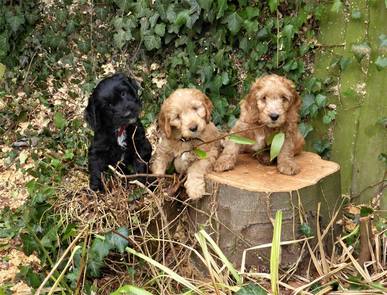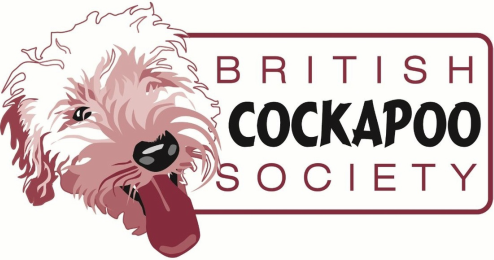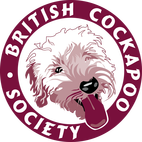EARLY DAYS SOCIALISATION
TRAINING
FROM 8 WEEKS OF AGE

Training your dog starts right from the day you take him into your family and how your dog is introduced to the day to day sights and sounds of the human world can ensure that he doesn't grow up fearful and stressed.
Below we will give you advice on how to start your puppy training and will guide you through to the obedience lessons that can be taught as your puppy matures.
Training isn't something that is done once a week by visiting a formal class, but is something that should be done daily, in your home, in the park, on your walks etc.
Training should ALWAYS be done with kindness and patience, and never through force or fear. NEVER put your dog under stress during training but be aware of how he is feeling, of he is happy and content, and if not draw back a little and try again later.
Always remember to make it fun, take it at your dogs pace, and always reward him using treats, fuss, praise etc.
Your puppy has a lot to learn -
Bite Inhibition
Getting used to being alone
Avoiding Resource Guarding
Toilet Training
Being groomed
Being touched and examined - ears, teeth, paws etc
Be people friendly
Being social with other dogs
First stages of obedience training - sit, come when called and so on
Quite a list isn't it, and these are just a few!!
Socialisation is an essential part of your pups education, and can set the stage for the type of dog it will grow up to be. It is well worth investing a bit of time and effort in the early days and building on it to make sure you have a happy and confident dog. Below we will give you information on the essential training needed to help your puppy grow into a confident and well mannered adult dog.
EARLY DAYS TRAINING
The first few weeks of your pup’s life with you is a really important time. Not only does he have to settle into your home environment and routine, it is also the time when the foundation of his adult behaviour is laid.
The following course will give you a week by week guide on how to introduce and teach your puppy about the outside world and all he needs to know about how to survive in the human world.
Take it at a pace that suits you and your dog, but do some daily. Go back over previous days to reinforce the training.
PLEASE NOTE - this course should be started in the first few days of your pup’s life with you. Even though he will not have had all his inoculations he should still be taken out, you just have to carry him instead of having him on the ground.
WEEK 1
Introduce your puppy to new experiences every day throughout the week. Reward your dog with high value treats during each experience. Below are just a few ideas of what your pup could see and meet in the early days -
EXPERIENCES
As you can see it is quite a list but the important thing is to judge your puppy and how he is coping with all this new information. You will be carrying him around at this stage as he wont have had his full quota of vaccinations. This gives you an ideal opportunity to see how he responds to all the stimuli, reassure him if needed and give him the small treats to show him he is doing well.
BEING HANDLED
As well as the list above, your puppy needs to get used to being handled and examined. He is going to need to be groomed regularly, brushed and combed daily and examined by the vet on his routine check ups or if he gets ill.
He needs to be able to cope with this without getting stressed or frightened and showing aggression.
Start by sitting calmly with him on your knee. Start gently touching his paws, separating the toes so to look in between them and examine the pads. Move on to his sides, tummy, ears, teeth etc until you have ‘examined’ all of him.
Don't forget to always reward your puppy for doing well.
KNOW YOUR NAME!
Teaching your puppy to respond to his name is so important. Start by sitting with him in a quiet area. Have someone gently holding him, then releasing him when you call his name and encourage him to come to you.
As he gets used to doing that, move further away, say “Fido...Come”, and give lots of praise and a tasty treat when he arrives. Eventually move out of sight, maybe in a different room and call him to you.
This is an ideal time to start using commands with your puppy and is the start of his training to come when called.
GETTING USED TO COLLAR AND LEAD
This is a vital part of your dogs education but something that not all puppies take to initially. Your breeder may have started the process by putting a small, very lightweight collar on your puppy before you picked him up, but if not then start as soon as you can to get him used to it.
The collar is often seen as an irritant to a young pup, so it is often better to start him wearing it in short bursts, and associate it being put on with something good, for instance, mealtimes.
When you feed your puppy, put his collar on, and the lead attached, and walk him to the area he gets fed. Give him his food and stand there holding his lead loosely while he eats.
When he has finished, walk him back to the living room with his collar and lead on, and then remove it. Keep doing this and then slowly increase the amount of time you leave his collar on.
REMEMBER!! NEVER leave your pups collar on when he is in his crate.
WEEK 2
For Week 2, continue each day with all the things you have been doing in the previous week, they will be an ongoing part of your dog’s education and just add in the following -
Below we will give you advice on how to start your puppy training and will guide you through to the obedience lessons that can be taught as your puppy matures.
Training isn't something that is done once a week by visiting a formal class, but is something that should be done daily, in your home, in the park, on your walks etc.
Training should ALWAYS be done with kindness and patience, and never through force or fear. NEVER put your dog under stress during training but be aware of how he is feeling, of he is happy and content, and if not draw back a little and try again later.
Always remember to make it fun, take it at your dogs pace, and always reward him using treats, fuss, praise etc.
Your puppy has a lot to learn -
Bite Inhibition
Getting used to being alone
Avoiding Resource Guarding
Toilet Training
Being groomed
Being touched and examined - ears, teeth, paws etc
Be people friendly
Being social with other dogs
First stages of obedience training - sit, come when called and so on
Quite a list isn't it, and these are just a few!!
Socialisation is an essential part of your pups education, and can set the stage for the type of dog it will grow up to be. It is well worth investing a bit of time and effort in the early days and building on it to make sure you have a happy and confident dog. Below we will give you information on the essential training needed to help your puppy grow into a confident and well mannered adult dog.
EARLY DAYS TRAINING
The first few weeks of your pup’s life with you is a really important time. Not only does he have to settle into your home environment and routine, it is also the time when the foundation of his adult behaviour is laid.
The following course will give you a week by week guide on how to introduce and teach your puppy about the outside world and all he needs to know about how to survive in the human world.
Take it at a pace that suits you and your dog, but do some daily. Go back over previous days to reinforce the training.
PLEASE NOTE - this course should be started in the first few days of your pup’s life with you. Even though he will not have had all his inoculations he should still be taken out, you just have to carry him instead of having him on the ground.
WEEK 1
Introduce your puppy to new experiences every day throughout the week. Reward your dog with high value treats during each experience. Below are just a few ideas of what your pup could see and meet in the early days -
EXPERIENCES
- Babies, toddlers and older children.
- Household noises - telephone, vacuum, washing machine etc.
- Other family pets.
- Take out to see other animals such as sheep, horses, cows etc.
- Meet people from different ethnic origins.
- Go shopping with your puppy to quiet shopping areas.
- Take your pup in the shops so he can see shopping trolleys and other noises.
- Go on trains, ferries, buses or trams and let your puppy see and hear traffic on the roads.
- Watch joggers and skateboarders.
- Allow your puppy to meet with puppy friendly, fully vaccinated dogs. Maybe you have family or friends with dogs that would be happy to meet your new puppy.
- Take your puppy to local parks so he can see swans, ducks and geese that may live there.
- Take your puppy to your local groomer to meet the staff and hear the hustle and bustle.
As you can see it is quite a list but the important thing is to judge your puppy and how he is coping with all this new information. You will be carrying him around at this stage as he wont have had his full quota of vaccinations. This gives you an ideal opportunity to see how he responds to all the stimuli, reassure him if needed and give him the small treats to show him he is doing well.
BEING HANDLED
As well as the list above, your puppy needs to get used to being handled and examined. He is going to need to be groomed regularly, brushed and combed daily and examined by the vet on his routine check ups or if he gets ill.
He needs to be able to cope with this without getting stressed or frightened and showing aggression.
Start by sitting calmly with him on your knee. Start gently touching his paws, separating the toes so to look in between them and examine the pads. Move on to his sides, tummy, ears, teeth etc until you have ‘examined’ all of him.
Don't forget to always reward your puppy for doing well.
KNOW YOUR NAME!
Teaching your puppy to respond to his name is so important. Start by sitting with him in a quiet area. Have someone gently holding him, then releasing him when you call his name and encourage him to come to you.
As he gets used to doing that, move further away, say “Fido...Come”, and give lots of praise and a tasty treat when he arrives. Eventually move out of sight, maybe in a different room and call him to you.
This is an ideal time to start using commands with your puppy and is the start of his training to come when called.
GETTING USED TO COLLAR AND LEAD
This is a vital part of your dogs education but something that not all puppies take to initially. Your breeder may have started the process by putting a small, very lightweight collar on your puppy before you picked him up, but if not then start as soon as you can to get him used to it.
The collar is often seen as an irritant to a young pup, so it is often better to start him wearing it in short bursts, and associate it being put on with something good, for instance, mealtimes.
When you feed your puppy, put his collar on, and the lead attached, and walk him to the area he gets fed. Give him his food and stand there holding his lead loosely while he eats.
When he has finished, walk him back to the living room with his collar and lead on, and then remove it. Keep doing this and then slowly increase the amount of time you leave his collar on.
REMEMBER!! NEVER leave your pups collar on when he is in his crate.
WEEK 2
For Week 2, continue each day with all the things you have been doing in the previous week, they will be an ongoing part of your dog’s education and just add in the following -
- Take your puppy to busy shopping centres, town centres and malls.
- Go on trains, buses and ferries if possible.
- Take your puppy to the school pick up, parks, etc so it can see children being noisy, running around, in pushchairs and so on.
- Call in to your local groomer (quick visit, not grooming done)
- Take your puppy to the shops and busy areas so he can see people of different ages, physical abilities, using walking aids or where he will see lots of people.
- Take him out n the car daily. Start with short trips and slowly increase so he can get used to the movement and sounds. ALWAYS have your dog secured in a crate or suitable car harness for every trip.
|
|
|

